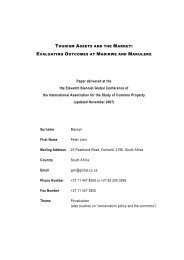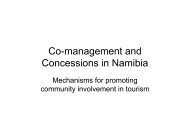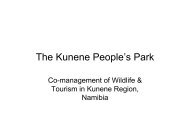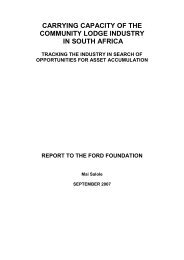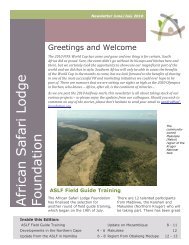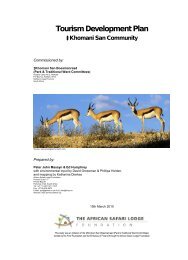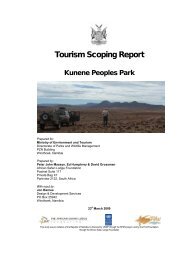socio-economic research on manda wilderness, lago district, niassa ...
socio-economic research on manda wilderness, lago district, niassa ...
socio-economic research on manda wilderness, lago district, niassa ...
You also want an ePaper? Increase the reach of your titles
YUMPU automatically turns print PDFs into web optimized ePapers that Google loves.
Less than half of the communities (6) have an improved water source. Mandambuzi probably has 2 as<br />
it is <strong>on</strong> a main road and therefore a more accessible locati<strong>on</strong> for infrastructure development.<br />
There were no flushing toilets in the 3 villages surveyed. Households rely <strong>on</strong> pit latrines for sanitati<strong>on</strong>.<br />
It is estimated by the Salt, Light and Health Project that 79% of families have a pit latrine in lakeshore<br />
villages although this percentage is lower inland.<br />
3.2.7 Health, Nutriti<strong>on</strong>al Status and Medical Services<br />
Nutriti<strong>on</strong>al and infant mortality estimates for May 2006 were to be provided by the Salt, Light and Health<br />
Project but were not obtained in time to be included in this report. Informati<strong>on</strong> <strong>on</strong> access to medical<br />
services was provided by the Community Liais<strong>on</strong> Officer. The following data can be compiled:<br />
a) Estimate of HIV infecti<strong>on</strong> rate (% ages 15-49) in the District.<br />
b) Estimate of malnutriti<strong>on</strong> rate am<strong>on</strong>gst children (% under age 5) in the District.<br />
c) Estimate of under-nutriti<strong>on</strong> rate am<strong>on</strong>gst children (% under age 5) in the District.<br />
d) Estimate of infant mortality rate (per 1,000 live births) in the District.<br />
e) Number of clinics in the village.<br />
f) Average number of hours from the village to nearest clinic by foot.<br />
HIV prevalence is estimated by the Salt, Light and Health Project to be around 30%. It is suspected<br />
that HIV and sexually transmitted disease rates have been rising due to cross border movement of<br />
people between Malawi and Mozambique. The number of orphans per household can be indicative of<br />
HIV/AIDS and is likely to increase in the future. The average number of orphans per household in the<br />
interview sample of 40 was 1.7.<br />
Only 2 out of 15 communities currently have clinics. Mbueca has a run down traditi<strong>on</strong>al structure<br />
operated by the Roman Catholic Church that may close in the future due to a lack of operati<strong>on</strong>al costs.<br />
Khango also has a clinic. A clinic is under c<strong>on</strong>structi<strong>on</strong> in Chigoma by MW.<br />
Table 6 Number of Clinics and Journey Time by Foot to Clinic per Community<br />
Community 7 e f<br />
Lakeshore: Clinic Hours to clinic<br />
1 Uchesse 0 3.0<br />
2 Chigoma under c<strong>on</strong>structi<strong>on</strong> 2.5<br />
3 Mataka 0 1.5<br />
4 Chikaya 0 1.0<br />
5 Khango 1 0.5<br />
6 Ut<strong>on</strong>ga 0 0.7<br />
7 Mala 0 1.5<br />
8 Mbueca 1 0.5<br />
Sub-Total 11.2<br />
Average 1.4<br />
Inland:<br />
9 Magachi 0 4.0<br />
10 Matepwe 0 4.0<br />
11 Mc<strong>on</strong>dece 0 3.0<br />
12 Litanda 0 5.0<br />
13 Mandambuzi 0 4.0<br />
14 Lukambwe 0 8.0<br />
15 Chissindo 0 10.0<br />
Sub-Total 38.0<br />
Average 6.3<br />
Total 2 49.2<br />
Average 3.3<br />
12



